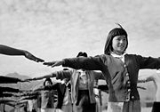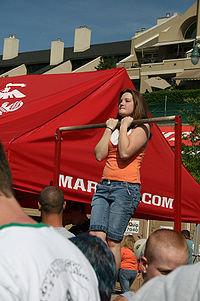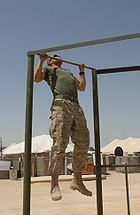
Calisthenics
Encyclopedia
Calisthenics are a form of aerobic exercise consisting of a variety of simple, often rhythmical, movements, generally using multiple equipment or apparatus. They are intended to increase body strength and flexibility with movements such as bending, jumping, swinging, twisting or kicking, using only one's body weight for resistance. They are usually conducted in concert with stretches
. Calisthenics when performed vigorously and with variety can benefit both muscular
and cardiovascular fitness
, in addition to improving psychomotor skills
such as balance, agility and coordination.
Groups such as sports teams and military units often perform leader-directed group calisthenics as a form of synchronized
physical training (often including a customized "call and response
" routine), in order to increase group cohesion
and discipline
. Calisthenics are also popular as a component of physical education in primary and secondary schools over much of the globe.
. Calisthenics originated in ancient Greece
, where it was mentioned in a Persian scout report on Sparta
n warriors before the Battle of Thermopylae
, with the Persians interpreting the odd synchronized movements as a form of dance
, and thus a sign of weakness .
Disciples of Friedrich Ludwig Jahn
brought their version of gymnastics to the United States, while Catherine Beecher and Dio Lewis set up physical education
programs for women in the 19th Century. Organized systems of calisthenics in America took a back seat to competitive sports after the Battle of the Systems
, when the states mandated physical education systems .
 In addition to the various stretches, some of the more common calisthenic exercises include:
In addition to the various stretches, some of the more common calisthenic exercises include:


Stretching
Stretching is a form of physical exercise in which a specific skeletal muscle is deliberately elongated, often by abduction from the torso, in order to improve the muscle's felt elasticity and reaffirm comfortable muscle tone. The result is a feeling of increased muscle control, flexibility and...
. Calisthenics when performed vigorously and with variety can benefit both muscular
Anaerobic exercise
Anaerobic exercise is exercise intense enough to trigger anaerobic metabolism. It is used by athletes in non-endurance sports to promote strength, speed and power and by body builders to build muscle mass...
and cardiovascular fitness
Aerobic exercise
Aerobic exercise is physical exercise of relatively low intensity that depends primarily on the aerobic energy-generating process. Aerobic literally means "living in air", and refers to the use of oxygen to adequately meet energy demands during exercise via aerobic metabolism...
, in addition to improving psychomotor skills
Psychomotor learning
Psychomotor learning is the relationship between cognitive functions and physical movement. Psychomotor learning is demonstrated by physical skills such as movement, coordination, manipulation, dexterity, grace, strength, speed; actions which...
such as balance, agility and coordination.
Groups such as sports teams and military units often perform leader-directed group calisthenics as a form of synchronized
Synchronized
Synchronized can refer to the following definitions:*synchronization , or syncronisation , the coordination of events to operate a system in unison.*Synchronized , a 2002 album by sHeavy....
physical training (often including a customized "call and response
Call and response
Call and response is a form of "spontaneous verbal and non-verbal interaction between speaker and listener in which all of the statements are punctuated by expressions from the listener."...
" routine), in order to increase group cohesion
Group cohesiveness
In general terms, a group is said to be in a state of cohesion when its members possess bonds linking them to one another and to the group as a whole. According to Festinger, Schachter, and Back , group cohesion was believed to develop from a field of binding social forces that act on members to...
and discipline
Discipline
In its original sense, discipline is referred to systematic instruction given to disciples to train them as students in a craft or trade, or to follow a particular code of conduct or "order". Often, the phrase "to discipline" carries a negative connotation. This is because enforcement of order –...
. Calisthenics are also popular as a component of physical education in primary and secondary schools over much of the globe.
History
The history of calisthenics is linked to Greco-Roman gymnasticsGymnastics
Gymnastics is a sport involving performance of exercises requiring physical strength, flexibility, agility, coordination, and balance. Internationally, all of the gymnastic sports are governed by the Fédération Internationale de Gymnastique with each country having its own national governing body...
. Calisthenics originated in ancient Greece
Ancient Greece
Ancient Greece is a civilization belonging to a period of Greek history that lasted from the Archaic period of the 8th to 6th centuries BC to the end of antiquity. Immediately following this period was the beginning of the Early Middle Ages and the Byzantine era. Included in Ancient Greece is the...
, where it was mentioned in a Persian scout report on Sparta
Sparta
Sparta or Lacedaemon, was a prominent city-state in ancient Greece, situated on the banks of the River Eurotas in Laconia, in south-eastern Peloponnese. It emerged as a political entity around the 10th century BC, when the invading Dorians subjugated the local, non-Dorian population. From c...
n warriors before the Battle of Thermopylae
Battle of Thermopylae
The Battle of Thermopylae was fought between an alliance of Greek city-states, led by King Leonidas of Sparta, and the Persian Empire of Xerxes I over the course of three days, during the second Persian invasion of Greece. It took place simultaneously with the naval battle at Artemisium, in August...
, with the Persians interpreting the odd synchronized movements as a form of dance
Dance
Dance is an art form that generally refers to movement of the body, usually rhythmic and to music, used as a form of expression, social interaction or presented in a spiritual or performance setting....
, and thus a sign of weakness .
Disciples of Friedrich Ludwig Jahn
Friedrich Ludwig Jahn
Friedrich Ludwig Jahn was a German gymnastics educator and nationalist. He is commonly known as Turnvater Jahn, roughly meaning "father of gymnastics" Jahn.- Life :...
brought their version of gymnastics to the United States, while Catherine Beecher and Dio Lewis set up physical education
Physical education
Physical education or gymnastics is a course taken during primary and secondary education that encourages psychomotor learning in a play or movement exploration setting....
programs for women in the 19th Century. Organized systems of calisthenics in America took a back seat to competitive sports after the Battle of the Systems
Battle of the Systems
The Battle of the Systems was a controversy over the most effective system of exercise and calisthenics that spanned from the 1830s to the early 1920s, consisted of different systems of exercise mostly in a gymnastic or calisthenic-type format...
, when the states mandated physical education systems .
Common exercises

- LungesLunge (exercise)The lunge is a strength training exercise that is used to strengthen the quadriceps muscles, gluteal muscles and the muscles comprising the "hamstrings", the semitendinosus, the semimembranosus, and the biceps femoris...
- Performed by bringing one leg forward and almost kneeling on the back leg. Once the front leg creates a perfect 90 degree angle you stand up and alternate legs. Keeping your back straight and chest out is important for proper form. There are many variations for lunges.
- Jumping jackJumping JackA jumping jack , stride jump or star jump , also called side-straddle hop in the US military, is a physical jumping exercise performed by jumping to a position with the legs spread wide and the hands touching overhead and then returning to a position with the feet together and the arms at the sides...
s
- Jumping jack
- Performed by jumping to a position with the legs spread wide and the hands touching overhead and then returning to a position with the feet together and the arms at the sides.
- Sit-upsSit-up (exercise)The sit-up is a strength training exercise commonly performed with the aim of strengthening the hip flexors and abdominal muscles. It begins with lying with the back on the floor, typically with the arms across the chest or hands behind the head and the knees bent in an attempt to reduce stress on...
- Sit-ups
- Performed by lying down with the back on the floor, knees bent, and bottoms of feet against the floor. The shoulders are then lifted off the floor by tightening abdominal muscles and bringing the chest closer to the knees. The final movement is to lower the back to the floor with a smooth movement. This trains the abdominal muscles.

- CrunchesCrunch (exercise)The crunch is one of the most common abdominal exercises. It primarily works the rectus abdominis muscle.-Form:A crunch begins with lying face up on the floor with knees bent. The movement begins by curling the shoulders towards the pelvis. The hands can be behind or beside the neck or crossed over...
- Like the sit-up, except instead of bringing the whole torso area closer to the knees, only a concentrated but shorter movement of the abdominals is performed. Shoulder blades are lifted off the floor, and abdominals tightened.
- Push-ups
- Performed face down on the floor, palms against floor under the shoulders, toes curled upwards against the floor. The arms are used to lift the body while maintaining a straight line from head to heel. The arms of the subject should go from fully extended in the high position to nearly fully flexed in the low position, while the subject makes sure to avoid resting on the floor. Resting is only done in the high position of the exercise. Chest, shoulders, and triceps are trained with this exercise.
- Pull-upsPull-up (exercise)A pull-up is an upper body compound pulling exercise where the body is suspended by the arms, gripping something, and pulled up with muscular effort...
- Pull-ups
- An overhead bar (sometimes called a chin-up barChin-up barChin-up bars are playground equipment that were once ubiquitous on children's playgrounds. They are still important in the adult equivalent of a playground, the Par course. A chin-up bar is simply a smooth horizontal metal bar, often a pipe, held solidly above ground by a wooden or metal frame...
) is grasped using a shoulder-width overhand (palms facing forward) grip. The subject lifts their body up, chin level with the bar, and keeping the back straight throughout. The bar remains in front of the subject at all times. The subject then slowly returns to starting position in a slow controlled manner. This primarily trains the latsLatissimus dorsi muscleThe latissimus dorsi , meaning 'broadest muscle of the back' , is the larger, flat, dorso-lateral muscle on the trunk, posterior to the arm, and partly covered by the trapezius on its median dorsal region.The latissimus dorsi is responsible for extension,...
or upper back muscles, as well as the forearms. An underhand grip variation or chin-upChin-upThe chin-up is a strength training exercise. The verb chinning means to do them. People frequently do this exercise with the intention of strengthening muscles such as the latissimus dorsi and biceps, which extend the shoulder and flex the elbow, respectively.It is a form of pull-up in which the...
trains both the back and biceps.- SquatsSquat (exercise)In strength training, the squat is a compound, full body exercise that trains primarily the muscles of the thighs, hips and buttocks, quads , hamstrings, as well as strengthening the bones, ligaments and insertion of the tendons throughout the lower body...
- Squats
- Standing with feet shoulder width apart, the subject squats down as far as possible, bringing the arms forward parallel to the floor. The subject then returns to standing position. Squats train the quadriceps, hamstringHamstringIn human anatomy, the hamstring refers to any one of the three posterior thigh muscles, or to the tendons that make up the borders of the space behind the knee. In modern anatomical contexts, however, they usually refer to the posterior thigh muscles, or the tendons of the semitendinosus, the...
s, calves, and gluteals.- Calf-raisesCalf raisesCalf raises are a method of exercising the gastrocnemius, tibialis posterior and soleus muscles of the lower leg. The movement performed is plantar flexion, aka ankle extension.-Bent-knee:...
- Calf-raises
- Standing on a platform with an edge where the heels can hang (e.g. a curbCurbCurb may refer to:* Curb , or kerb, the edge where a raised pavement/sidewalk/footpath, road median, or road shoulder meets an unraised street or other roadway.* Curb Records, a record label started by Mike Curb in 1973....
), lift the body on the balls of the feet. The subject then slowly returns to starting position. This trains the gastrocnemius. A seated calf-raise trains the soleus.

- DipsDip (exercise)The dip is an exercise used in strength training. Normal, shoulder-width dips primarily train the triceps, with major synergists being the anterior deltoid, the pectoralis muscles , and the rhomboid muscles of the back...
- Done between parallel bars or facing either direction of trapezoid bars found in some gyms. Feet are crossed with either foot in front and the body is lowered until the elbows are in line with the shoulders. The subject then pushes up until the arms are fully extended, but without locking the elbows. Dips focus primarily on the chest, triceps, and deltoids.
- Flutter kickFlutter kickThe flutter kick is a kicking movement used in both swimming and calisthenics.-Swimming:When swimming either front crawl or backstroke, the legs are extended straight backwards in line with the body. They are moved up and down, one leg kicking downwards as the other leg moves up...
- Flutter kick
- Lying on your back, hands in fists under buttocks, move feet up and down near the ground.
General uses
- As warm-up preceding sportSportA Sport is all forms of physical activity which, through casual or organised participation, aim to use, maintain or improve physical fitness and provide entertainment to participants. Sport may be competitive, where a winner or winners can be identified by objective means, and may require a degree...
activity. - As part of a work-out to burn food energyFood energyFood energy is the amount of energy obtained from food that is available through cellular respiration.Food energy is expressed in food calories or kilojoules...
without gym equipment.
See also
- Alexander techniqueAlexander TechniqueThe Alexander Technique teaches the ability to improve physical postural habits, particularly those that have become ingrained and conditioned responses...
- Bodyweight exerciseBodyweight exerciseBodyweight exercises are strength training exercises that do not require free weights; the practitioner's own weight provides the resistance for the movement...
- Fitness trailFitness trailA fitness trail consists of a path or course equipped with obstacles or stations distributed along its length for exercising the human body to promote good health. The course is designed to promote physical fitness training in the style attributed to Georges Hébert...
- GymnasticsGymnasticsGymnastics is a sport involving performance of exercises requiring physical strength, flexibility, agility, coordination, and balance. Internationally, all of the gymnastic sports are governed by the Fédération Internationale de Gymnastique with each country having its own national governing body...
- PilatesPilatesPilates is a physical fitness system developed in the early 20th century by Joseph Pilates in Germany, the UK and the USA. As of 2005, there were 11 million people practicing the discipline regularly and 14,000 instructors in the United States....
- SportSportA Sport is all forms of physical activity which, through casual or organised participation, aim to use, maintain or improve physical fitness and provide entertainment to participants. Sport may be competitive, where a winner or winners can be identified by objective means, and may require a degree...
- 5BX5BXThe 5BX Plan is an exercise program developed for the Royal Canadian Air Force by Bill Orban in the late 1950s, first published in 1961. The plan was developed for men; a corresponding program was developed for women under the name XBX .-The 5BX plan:The 5BX Plan is composed of six charts...

